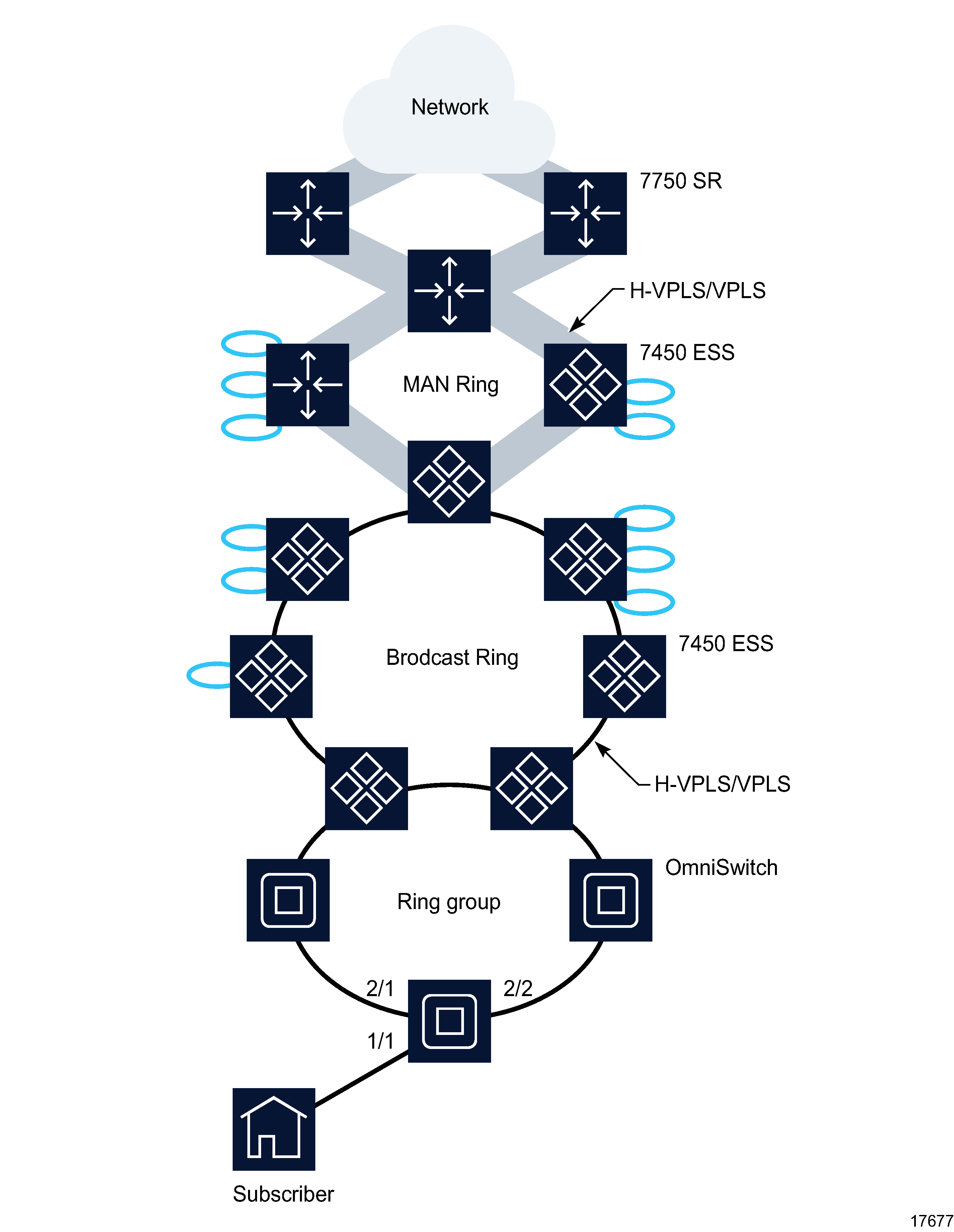VLAN service management overview
VLAN ring groups
VLAN ring groups are used to send traffic across an Ethernet ring using copper or fiber optic connections from the source traffic device, for example, from a 7450 ESS, to all devices in the ring. STP configuration on OmniSwitch devices ensures that there is a constant stream of traffic in either direction by rerouting traffic around breaks in the physical links between the devices. The following figure shows an example of a ring group that is part of a larger metropolitan area network.
Figure 75-1: Ring in a metropolitan and broadcast network

The NFM-P provides OAM tools for service validation and for troubleshooting service and network transport issues.You can run the OAM Validation test suite for the VLAN service by clicking on the Validate button or by clicking on the More Actions button and choosing Validate. Alternatively, you can also perform a One Time Validation. If a check mark appears beside the OAM Validation Failed state cause indicator, the test has failed. In addition, the Tested Entity Result tab on the Tests tab displays more detailed information about the OAM test result. See Chapter 89, Service Test Manager for more information about how to configure OAM validation test suites.
The Aggregated Service Site Operational State parameter has four possible values. The value is derived from the operational states of the sites that are part of the service, as follows:
When the Aggregated Service Site Operational State parameter is Partially Down or Down, a check mark appears beside the appropriate State Cause indicator to identify the type of fault to the NFM-P operator. You can view alarms on the Faults page.
When you use the NFM-P to create or discover a service, the NFM-P assigns a default tier value to the service. The Service Tier parameter value is relevant only in the context of composite service topology map views. See Chapter 85, Composite service management for more information about the hierarchical organization of composite services.
VLAN groups
The NFM-P supports the configuration and provisioning of VLAN groups which are used by the following NEs.
You can use VLAN groups to:
-
logically group OmniSwitch and Wavence SM devices to represent a typical network topology. An OmniSwitch and a Wavence SM cannot belong to the same VLAN group.
-
manage the VLAN IDs that are assigned to Wavence SM VLAN group members.
See To create a VLAN group for more information about creating OmniSwitch VLAN groups. See “Wavence microwave backhaul service management” in the NSP NFM-P Microwave Radio User Guide for information about creating Wavence VLAN groups.
OmniSwitch VLAN service policies
Policies can be assigned to ports on an OmniSwitch. Policies are defined at a global level and then applied to components of the service, such as a port.
The policy on the component is then a local version of the global policy. The following policies are common to VLAN services:
-
QoS policies define ingress classification, policing, shaping, and marking on the device.
-
UNI policies define how control frames that are received on a port are processed. UNI policies are applied to a port that is used as a SAP in a L2 VPN TLS (stacked) VLAN.
-
SAP policies define traffic engineering parameters for bandwidth sharing, rate limiting, CVLAN translation (or double-tagging), and priority bit mapping. SAP policies are applied to the service access multi-point.
-
Filter policies control network traffic into or out of an interface or device based on IP or MAC matching criteria.
See Chapter 49, Policies overview for more information about policies.
OmniSwitch network management
The NFM-P manages OmniSwitch devices using SNMP and CLI messages. OmniSwitch devices support termination of all VLAN types on Ethernet ports.
Spanning tree protocols
The STP configuration on an OmniSwitch device in a VLAN group detects loops in the topology and ensures that there is a constant stream of traffic by rerouting traffic around breaks in the physical links between the devices. OmniSwitch devices support STP, MSTP and RSTP.